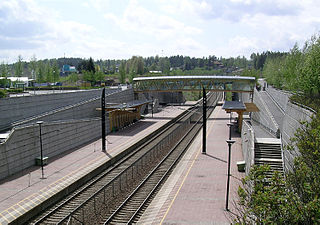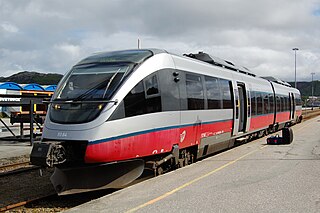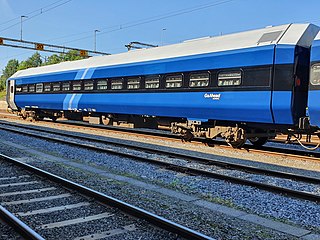
Night trains of Norway (Norwegian: Nattog) are over-night sleeping car services provided by three different operators on four routes across Norway. There is an additional night train that runs mostly through Sweden from Stockholm to Narvik.
Contents


Night trains of Norway (Norwegian: Nattog) are over-night sleeping car services provided by three different operators on four routes across Norway. There is an additional night train that runs mostly through Sweden from Stockholm to Narvik.

The 2024 timetables for trains within Norway show there is one night train with sleeper carriages in each direction each day except Saturday between:
A night train usually consists of 5 to 7 coaches:
All sleeper services use the WLAB-2 carriages. These carriages were built by Strømmens and introduced in 1986, there are 20 in service. Each carriage is 27 m (89 ft) long and has 15 compartments, one of which is fitted for disabled access, available for single or double occupancy, the bunks being one above the other, toilets are situated at the ends of the carriage. The carriages had a mid-life upgrade in 2007. [5] [6]
El 18 locomotives are used on the Bergen, Dovre and Sørland Lines, while the service on the Nordland Line is provided using Di 4 engines.[ citation needed ]
A sleeper train runs from Stockholm Central to Kiruna and Narvik in Norway. In 2024 these passenger services are operated by Vy Tåg, a subsidiary of the former Norwegian State Railways which won the operating contract, but SJ, a state-owned passenger train operator in Sweden, has won back the contract from 15 December 2024 onwards. [7]
The trains have 1st class 1 & 2 berth sleepers with private toilet & shower, 2nd class 3 bed sleepers with washbasin, 6-berth couchettes, ordinary seats, cafe car. [8]
The first sleeper train on this line was introduced in October 1917 when a sleeper coach was attached to a mixed traffic train. [9]
Three sleeping cars were first introduced in 1884 on the Røros Line, the coaches were categorised as Bo, 2nd class bogie coaches, they had full length clerestory roofs. [10]
The Kongsvinger Line had its first two sleeping cars from 1891, these carriages categorised ABo, composite 1st and 2nd class bogie coaches, were used for services to Stockholm. [10]
By 1914 over-night trains with sleeping coaches were running between Oslo (it was called Kristiania at the time) and Trondheim, Skien and Bergen within Norway and to Stockholm and Copenhagen. [11]
The 1939 Cook's Continental timetables show sleeper services to Trondheim, Åndalsnes, Kristiansand and Bergen within Norway and to Stockholm, Copenhagen, Malmo and Hamburg. [12]
The first steel-bodied sleeping cars were introduced in 1939 (by which time there were 90 wooden-bodied sleeping cars of six different types, of which 19 had been rebuilds of existing coaches) a further three were followed in 1940–1941 when the war interrupted. In 1951 there were 15 more provided and between 1956 and 1965 a further 29, most of which were still running in 1995, several having been rebuilt. [10]
Between 9 June 1953 and 26 May 1962 a sleeper service was provided to Oslo when the international Compagnie Internationale des Wagons-Lits (CIWL) extended one of the carriages of the Nord Express (Paris to Copenhagen train) from Copenhagen, the carriage used the train ferry from Helsingør in Denmark to Helsingborg in Sweden, through Goteborg, crossing the border at Kronsjo and on to Oslo. [13] [14]

SJ is a state-owned passenger train operator in Sweden. SJ was created in 2001, out of the public transport division of Statens Järnvägar, when the former government agency was divided into six separate state-owned limited companies. In 2018, SJ carried 31.8 million passengers.

The Norwegian railway system comprises 4,109 km of 1,435 mm track of which 2,644 km is electrified and 274 km double track. There are 697 tunnels and 2,760 bridges.

Vygruppen, branded as Vy, formerly the Norwegian State Railways, is a government-owned railway company which operates most passenger train services and many bus services in Norway. The company is owned by the Norwegian Ministry of Transport. Its sub-brands include Vy Buss coach services, CargoNet freight trains and the Swedish train transport company Tågkompaniet. In 2009, NSB carried 52 million train passengers and 104 million bus passengers. On 24 April 2019, passenger train and bus services were rebranded as Vy.

The Dovre Line is a Norwegian railway line with three slightly different lines which all lead to the historic city of Trondheim.

Oslo Central Station is the main railway station in Oslo, and the largest railway station within the entire Norwegian railway system. It connects with Jernbanetorget station, which is served by trams and the Oslo Metro. It's the terminus of Drammen Line, Gardermoen Line, Gjøvik Line, Hoved Line, Østfold Line and Follo Line. It serves express, regional and local rail services by four companies. The railway station is operated by Bane NOR while its real estate subsidiary, Bane NOR Eiendom owns the station, and was opened in 1980.
Linx AB was a railway company which operated inter-Scandinavian passenger trains between 2001 and 2004. Established as a joint venture between the Norwegian State Railways (NSB) and the Swedish state-owned SJ, Linx operated the routes from Oslo, Norway, to Stockholm, Sweden, and from Oslo via Gothenburg, Sweden, to Copenhagen, Denmark. Services were provided up to ten times per day. However, slow speeds caused by curvy infrastructure in Norway, combined with competition from low-cost airlines, caused the company to lose money, and eventually grounded operations. The services were taken over by NSB and SJ. The main rolling stock were eleven X2 electric multiple units, although it used SJ Rc-hauled trains on the Gothenburg–Oslo service. The company was based in Gothenburg.

The Gardermoen Line is a high-speed railway line between Oslo and Eidsvoll, Norway, running past Lillestrøm and Oslo Airport, Gardermoen. The line is 64 kilometres (40 mi) long and replaced the older Hoved Line as the main line north-east of Oslo. The older Hoved Line now handles commuter and freight traffic, while the Gardermoen Line handles high-speed passenger trains and freight trains laden with jet fuel for the airport. Both lines are owned by Bane NOR.

The Ofoten Line is a 43-kilometre (27 mi) railway line in Narvik Municipality, Norway. It runs from the Port of Narvik to Riksgränsen on the Norway–Sweden border, where the line continues as the Ore Line via Kiruna and Gällivare to Luleå. The Ofoten Line is single track, electrified at 15 kV 16.7 Hz AC and has seven stations. The line only connects to the rest of the Norwegian railway network via Sweden. The main traffic is up to 12 daily freight trains operated by Malmtrafik that haul iron ore from Sweden to Narvik. In addition, CargoNet operates container trains, branded as the Arctic Rail Express (ARE), and Vy Tåg operates passenger trains, including a night train to Stockholm.

NSB Class 73 is a class of 22 electric multiple units built by Adtranz for the Norwegian State Railways. The four-car trains were modifications of Class 71, which was again based on the Swedish X2. The A-series consists of 16 intercity trains; they were delivered in 1999 and 2000 and are used on the Bergen, Dovre and Sørland Lines. The intercity service was branded as Signatur until 2003. The B-series consists of six regional trains delivered in 2002 and used on the Østfold Line. The regional trains were originally part of the Agenda concept. The trains have a power output of 2,646 kilowatts (3,548 hp) and a maximum speed of 210 km/h (130 mph). They have an overall length of 108 meters (354 ft) and have a capacity for 208 seated passengers in the A-series and 250 in the B-series. The trains have a tilting mechanism allowing for faster travel through curves.

Class 93 is a tilting two-carriage diesel multiple unit used by SJ Norge for passenger trains on non-electrified stretches of the Norwegian railway network. Used on the Nordland Line, the Røros Line and the Rauma Line, they were purchased to replace the aging Di 3 locomotive-hauled trains. The Class 93 was produced by Bombardier, and is part of the Talent family. Fifteen units were delivered between 2000 and 2002.
There are three basic types of Norwegian railway carriage used commonly by NSB on the Norwegian railway system, the Class 3, Class 5 and Class 7 series. As of 2005, the carriages are hauled by NSB El 18 engines on the main electrified stretches and NSB Di 4 engines on non-electrified lines.

The Iron Ore Line is a 398-kilometre (247 mi) long railway line between Riksgränsen and Boden in Norrbotten County, Sweden, owned by Trafikverket. The line also contains two branches, from Kiruna to Svappavaara and from Gällivare to Koskullskulle. The term is often colloquially used to also include the Ofoten Line, from Riksgränsen to Narvik in Norway, and the northernmost part of the Main Line Through Upper Norrland from Boden to Luleå. The railway from Narvik to Luleå is 473 kilometres (294 mi) long.

Vy Buss, formerly branded as Nettbuss, is the largest bus company in Norway, owned by Vy. It was established on 10 February 2000 as the continuation of the bus operations from former NSB Biltrafikk. In addition to bus services in major parts of Norway, it also operates buses in Sweden through subsidiaries.

Trondheim Central Station or Trondheim S is the main railway station serving the city of Trondheim, Norway. Located at Brattøra in the north part of the city centre, it is the terminus of the Dovre Line, running southwards, and the Nordland Line, which runs north. The railway is electrified south of the station but not north of it, so through trains must change locomotives at the station.

Oslo Airport Station, also known as Gardermoen Station, is a railway station located in the airport terminal building of Oslo Airport, Gardermoen in Norway. Located on the Gardermoen Line, it is served by the Airport Express Trains, express trains to Trondheim and Oslo, regional trains to Lillehammer and Skien and commuter trains to Eidsvoll and Kongsberg.
Ofotbanen Drift AS, trading as Ofotbanen, was a Norwegian passenger and freight railway company. The company operated a fleet of six locomotives, three multiple units, 22 passenger and 48 freight cars. The sole service was the passenger train Unionsexpressen between Oslo and Stockholm; it had previously offered freight haulage on contract.

Narvik is a railway station located in Narvik Municipality in Nordland, Norway on the Ofoten Line. The station is located about 3.7 kilometres (2.3 mi) from the end of the line at the Port of Narvik.

Unionsexpressen was an intercity train service provided between Oslo and Stockholm, the capitals of Norway and Sweden. The first-class only service was operated by company Unionsexpressen Scandinavian Railway AB, while haulage and Norwegian representation was operated by Ofotbanen.

NSB WLAB-2 or WLAB2 is a class of twenty sleeping cars built by Strømmens Verksted for the Norwegian State Railways (NSB). They serve as the sole sleepers in Norway, being used on the Bergen Line, Dovre Line, Nordland Line and Sørlandet Line. Each car features fifteen compartments, which can each be utilized with a single or twin bunk configuration. The carriages have a unique octagonal shape, are 27 meters long and weigh 48 tonnes.
Night trains of Sweden are over-night sleeping car services provided by three different operators across Sweden, one of these trains terminates in Narvik in Norway, and one runs from Stockholm to Berlin.